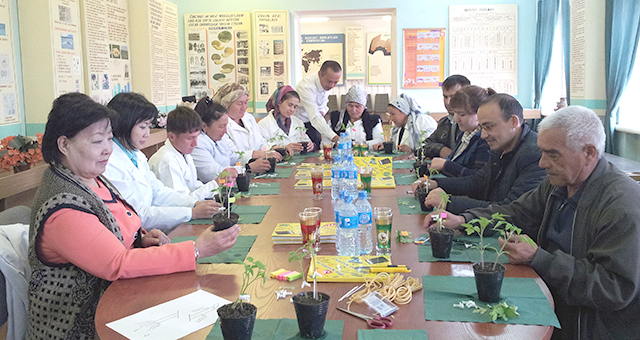
The greenhouse vegetable production in the countries of Central Asia and the Caucasus (CAC) is significantly below its potential due to a number of biotic and abiotic factors, including soil diseases (fusarium and nematodes), causing significant damage to plants and yields. Various methods of vegetable grafting, e.g. tomato, pepper, eggplant, cucumber and watermelon, have been used successfully worldwide to improve the yield of these crops in the open field and greenhouse production.
Grafting of seedlings is not only one of the ways to preventing diseases, it also strengthens the root system and improves water consumption and inorganic nutrition of plants. As such, production and marketing of the grafted seedlings of vegetables adapted to local conditions is cost effective and allows farmers to generate good returns.
With the aim of developing national capacity on vegetable grafting technology, the Research Institute of Vegetable, Melon Crops and Potato hosted a training course for young specialists, conducted on March 24, 2016 in Tashkent, Uzbekistan. The training was attended by 12 young researchers of the Research Institute, who were awarded Certificates upon successful completion of the course.
During the sessions, participants were acquainted with the theoretical aspects of vegetable grafting technology, as well as with the practice of grafting tomato seedling. It is pleasing to note that practical lessons of the course accomplished by the trainees was marked by a high percentage of survival rate of the grafted seedlings. Practiced technologies are well suited for grafting not only tomato, but also cucumber, eggplant, melon, watermelon and other crops.
The training was organized by the Regional Office of the International Center for Agricultural Research in the Dry Areas (ICARDA) in collaboration with the World Vegetable Center - AVRDC, which has extensive experience in developing grafting methods for vegetable crops. As a result of the collaboration with the Uzbek Research Institute of Vegetable, Melon Crops and Potato carried out over the last few years, there are number of tomato entries and breeding lines that have been introduced by the World Vegetable Center for the evaluation of their agronomic traits and suitability for grafting, including promising cultivars selected for seedling rootstock in Uzbekistan.
Improving and adaptation of grafting method through the Research Institutes will contribute to the transition to a new scientifically based level of production of high-quality vegetables. By cultivation of high quality grafted planting materials (seedlings), vegetable growers will be able to skip many plant protection measures, improve the quality and yield of the vegetables, and promote a more environmentally friendly method of vegetable production.